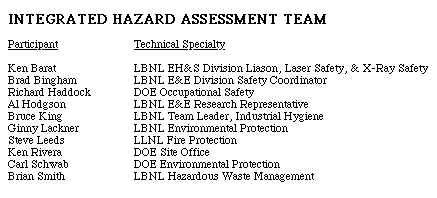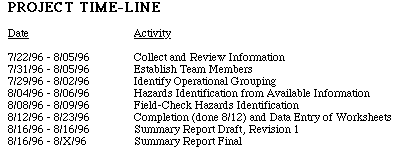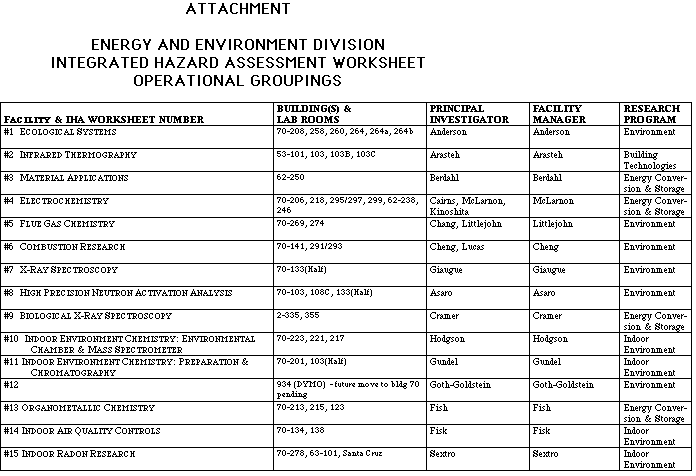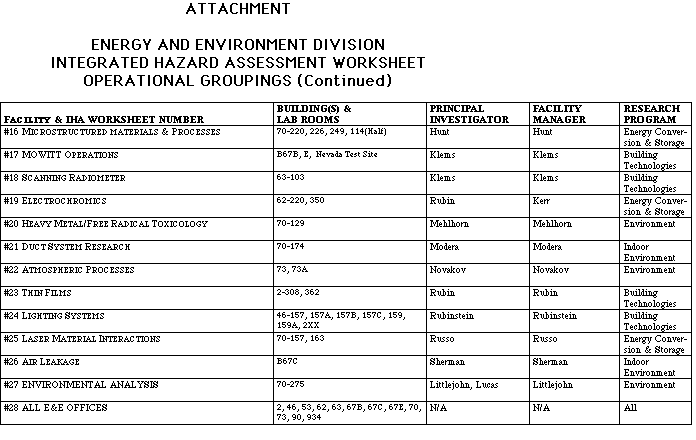ENERGY & ENVIRONMENT DIVISION
DRAFT
pending team review

|
Environment,
Safety, and Health INTEGRATED HAZARD APPRAISAL of BERKELEY
LAB ENERGY & ENVIRONMENT DIVISION
DRAFT
| 
|
| for Work and Hazards Identification to Define the Necessary and Sufficient Standards Set and Direct Appraisal Efforts | |
INTRODUCTION
This report initially identifies the work activities and hazards that are present in the E. O. Lawrence Berkeley National Lab (Berkeley Lab or LBNL) ) Energy and Environment Division (E&E) as part of the Integrated Hazard Assessment (IHA) process. Activities and hazards were identified in preparation for:
In late July 1996, a multi-disciplinary team of research and EH&S representatives from Berkeley Lab, Department of Energy (DOE) Oakland Operations, and Lawrence Livermore National Laboratory (LLNL) was identified (note team listing below). Team members and contributors met four or more times to review available work activity and hazard information, identify hazards related to activities, field-check findings, and complete IHA worksheets. IHA worksheet information was then entered into the IHA information management system and reviewed for quality.
E&E Division activities were divided into 28 areas of similar work activities or research objectives. Facility Notebooks were previously developed for most of these 28 areas. A list of these 28 areas is attached. One IHA worksheet was completed for each of the 28 areas. The first 27 worksheets cover E&E research activities; the last worksheet covers all E&E office areas. Worksheets are available on the Berkeley Lab website. Building floor plans that show E&E spaces are attached to hard copies of this report.
The body of this report summarizes the IHA team participants, project time-line, E&E organization and management, ES&H performance expectations and objectives, E&E actions to be performed, E&E physical conditions within which the work will be performed, E&E materials and conditions that could cause adverse consequences, uncertainties about the work, EH&S resource availability and constraints, and stakeholder concerns.


ORGANIZATION AND MANAGEMENT
The Energy & Environment (E&E) Division is made up of five Research Programs, three Coordinating Centers, one Research Unit, and a Washington D. C. Office. E&E organization charts are attached to hard-copies of this report. The five Research Programs are:
On-site operations are located in Berkeley Lab buildings B2, B46, B53, B62, B63, B67B, B67C, B67E, B70, B90, B73, and B934. Major locations of E&E personnel and research activities are located in B70 and B90. Building floor plans that note E&E research operation ownership are attached.
E&E has approximately 366 personnel in the following categories: 119 scientific staff, 100 technical staff, 50 administrative staff, 50 UCB Facility/staff, and 47 graduate student Research Assistants. Operations on the University of California Berkeley (UCB) campus are primarily in the XXXXX????? Departments.
E&E Principal Investigators report to one of five Program Heads, who in turn report to the E&E Division Council and Division Directors office. The division also has five Coordinating Centers, Research Unit, and/or Office Heads who report to the Division Director's office. These organizations coordinate interdisciplinary research within the Division and foster partnerships with outside agencies.
The Principal Investigators are accountable for the scientific excellence, relevance to the DOE mission, and fiscal integrity of their programs, as well as adherence to regulatory requirements. The Division Safety Committee Chairperson, Al Hodgson, is charged with disseminating safety information, lab-wide safety programs, and OAA programs. To aid the committee, Brad Bingham serves as Division Safety Coordinator.
PERFORMANCE EXPECTATIONS AND OBJECTIVES
Research Program Management Responsibility for Safety
Line Management is responsible for the protection of the public, the workers, and the environment.
At the Berkeley Laboratory the following documents establish the policy and provide the implementation guidance that makes line management effectively accountable for protection of workers, the public, and the environment:
Clear Roles and Responsibilities
Clear and unambiguous lines of authority and responsibility for ensuring safety are established and maintained at all organizational levels within the Division and its contractors.
Each Division making up the Berkeley Laboratory has clearly defined lines of responsibility down to the working level. Each division designates a research investigator to represent its views and concerns on the Laboratory Safety Review Committee and a full time employee to act as the ES&H Coordinator. This Coordinator acts as the interface between ES&H concerns, compliance in the workplace, and the EH&S technical professionals. Organizational information is updated routinely and is retained in the Functional/Facility Notebooks as appropriate (see OAP).
Competence Commensurate with Responsibilities
Personnel possess the experience, knowledge, skills, and abilities that are necessary to discharge their responsibilities.
Job assignments, including hires, are reviewed by line management and by the compensation group within Human Resources to ensure that the requirements and responsibilities of a job are matched by the experience, knowledge, and skills of individuals selected for assignment. Performance expectations for managers and supervisors in the Divison match the talents, knowledge, and skills of staff to work assignments and responsibilities.
The Laboratory's training program ensures that each staff member, including participating guests, is adequately trained to participate safely in Laboratory activities. Staff, with supervisor participation, fill out the Jobs Hazards Questionnaire (JHQ) describing the hazards associated with their job assignment and work area. Evaluation of the responses by the Training Coordinator and the cognizant supervisor determines the training regimen needed to carry out work in a manner that protects the employee, co-workers, the public, and the environment.
Balanced Priorities
Resources are effectively allocated to address safety, programmatic, and operational considerations. Protecting the public, the workers, and the environment is a priority whenever activities are planned and performed.
All environment, safety, and health activities in the Laboratory are described in technical terms with budgetary information included. Each year this information is updated, reviewed and prioritized on the basis of risk to workers, public, and the environment by a Laboratory-wide committee selected to represent programmatic line management and ES & H professionals. This document is utilized by Laboratory Senior Management in strategically planning the immediate focus and long-term goals of the environment, safety, and health program at the Laboratory.
Hazard Controls Tailored to Work Being Performed
Administrative and engineering controls to prevent and mitigate hazards are tailored to the work and associated hazards being performed.
Chapter 6 of the Environment, Health, and Safety Manual clearly defines the steps for each line manager to develop the appropriate engineering and administrative controls to mitigate hazards in the workplace. The Laboratory's Self Assessment Program, including Functional Appraisals by ES & H professionals, and the UC/DOE Contract 98 Performance Measures provide assurance that implementation of hazards control is adequate to protect the worker, the public, and the environment.
Identification of Safety Standards and Requirements
Before work is performed, the associated hazards are evaluated and an agreed-upon set of safety standards and requirements are established which, if properly implemented, provide adequate assurance that the public, the workers, and the environment are protected from adverse consequences.
The Laboratory is dedicated to following the Necessary and Sufficient Closure Process (DOE 450.3) on an iterative basis at all levels of activities in the Laboratory to ensure the Safety Standards are adequate to provide protection to workers, the public, and the environment. This process is completed by commencement of work in those situations where current work is significantly modified, new work is proposed, or substantial facility modifications are being made (Chapter 6, Environment Health and Safety Manual).
Operations Authorization
The conditions and requirements to be satisfied for operations to be initiated and conducted are clearly established and agreed-upon.
Conditions and requirements for facilities determined to be of higher risk based on the Integrated Hazards Analysis are contained in a Safety Analysis Document. Activity Hazard Documents are the basis for meeting this requirement for specific operations and activities falling into the higher risk category at the Berkeley Laboratory. Internal Agreements describing the performance expectations by each party are used for operations between two functional areas where the quality of performance might adversely impact the Laboratory's ability to meet its responsibility to protect workers, the public, and the environment.
ACTIONS TO BE PERFORMED
The following are brief summaries of the functions and missions of each E&E Division Research Program, Coordinating Center, and Research Unit.
Building Technologies Research Program
The Building Technologies Program focuses on two major systems in buildings: windows and lighting. The program also has a goal to create advanced simulation and design tools that enable building professionals to fully integrate energy efficient technologies into new and existing buildings and to extend the market penetration of these technologies. This program consists of four sub-programs: Windows & Daylighting, Simulation Research, Lighting Systems, and Advanced Building Systems.
Energy Analysis Research Program
The Energy Analysis Program focuses on energy use rather than energy extraction or conversion. The program develops and uses an array of simulation models for estimating the impacts of energy efficient technologies in buildings, appliances, urban environments, and utility resource plans. This sub-program consists of six sub-programs: Building Energy Analysis, Utility Planning and Policy, International Energy Studies, Global Energy/Environmental Issues, Energy Conservation Policy, and Technology Policy Assessment.
Indoor Environment Research Program
The Indoor Environment Program conducts integrated research on ventilation, indoor air quality, and efficient energy use in buildings. This includes infiltration and thermal distribution systems, and human exposure to indoor air pollutants. The program consists of three (or five???) subprograms: Building Interactions, Sources & Dynamics, and Assessment (or Energy Performance of Buildings, Indoor Chemistry, Indoor Radon, Exposure and Risk Analysis, and Indoor Air Quality Studies?????).
Environmental Research Program
The Environmental Research Program's goal is to understand and mitigate anthropogenic effects on the environment. Researchers investigate and develop efficient and environmentally benign combustion, methods of pollution abatement and, destruction of toxic pollutants, and novel methods of detection and analysis of criteria and noncriteria pollutants. This program consists of four sub-programs: Combustion Process, Ecological Systems, Atmospheric Processes, Flue-Gas Chemistry.
Energy Conversion and Storage Research Program
Energy Conversion & Storage, this program is developing new processes and materials for more efficient environmental benign energy conversion and storage technologies. Projects focus on transport-process principles, chemical kinetics, thermodynamics, separation processes, organic and physical chemistry, novel materials and advanced methods of analysis. The program is made up of three sub-programs: Material Applications, Chemical Applications, and Electrochemistry.
Coordinating Centers
The Center for Atmospheric & Biospheric Effects of Technology, Center for Building Science, and Berkeley Electrochemical Research Center coordinate interdisciplinary research within the Division.
California Institute for Energy Efficiency Research Unit
The California Institute for Energy Efficiency is a UC-organized research & development partnership of utilities, energy agencies, and research facilities.
PHYSICAL CONDITIONS
WITHIN WHICH THE WORK WILL BE PERFORMED
On-site operations are located in Berkeley Lab buildings B2, B46, B53, B62, B63, B67B, B67C, B67E, B70, B90, B73, and B934. Major locations of E&E personnel and research activities are located in B70 and B90. Building floor plans that note E&E research operation ownership are attached.
Building 2
B2 is a late-1980s-vintage, four-story laboratory and office building. Note the attached floor plans of B2 E&E operations. Only four of the approximately 65 research lab rooms in B2 belong to E&E. These four labs belong to two different E&E groups: Thin Films and X-Ray Spectroscopy.
Building 46
B46 is an older, long, two-story metal-siding building. The E&E Lighting Systems facility occupies work and lighting systems testing areas on the first and second floors of a portion of the building.
Building 53
B53 is an older, metal-siding building with the ground floor at different elevations. The Infrared Thermography facility occupies only four research areas in this building.
Building 62
B62 is a concrete-structure, three-story lab and office building. Only three or four of the 31 lab rooms in B62 belong to E&E. Note the attached floor plans of B62 operations. These areas belong to two different E&E groups: Electrochromics and Materials Applications. Electrochromics operations utilize inert-atmosphere gloveboxes. Lab hoods are present.
Building 63
B63 is a small, high, one-story metal structure with interior wood-stud and some sheetrock rooms. Only one E&E facility occupies this building: Building Technologies Scanning Radiometer.
Buildings 67B, 67C, and 67E
B67B, B67C, and B67E are trailers in the Blackberry Canyon parking lot that house offices and two E&E research facilities: Building Technologies Mowitt Operations and Indoor Environment Air Leakage.
Building 70
B70 is an older, concrete-structure, large, two-story lab and office building. Labs typically have lab hoods exhausted to single blowers on the roof. Note the attached floor plans of B70 E&E operations. E&E occupies roughly two-thirds of the lab space in B70. Sixteen of the 27 E&E Research "Facilities" are contained in B70.
Building 73
B73, The Aerosol Research Building, is located in Strawberry Canyon and is accessible via Centennial Drive. B73 is a single-story, two-level, wood-frame building with three or four lab spaces, offices, and a very small shop. B73 is only occupied by one E&E facility: Atmospheric Processes. Two labs hoods are present.
Building 934
B934 is a large, single-story rented lab and office building located adjacent to Berkeley Aquatic Park near Interstate 880. Only one life science and environmental research-oriented E&E facility is located at B934. All other labs at B934 belong to the Life Science Division.
University of California Berkeley
Operations on the University of California Berkeley (UCB) campus are primarily located in ????? Halls.
MATERIALS AND CONDITIONS
THAT COULD CAUSE ADVERSE CONSEQUENCES
Typical materials and conditions that could cause adverse consequences if not controlled are listed below. These examples are first listed by Necessary and Sufficient requirements identification topic areas, and then by hazard categories. Typical levels of concern (LOC) are also shown based on the estimated level of control that is implemented or achievable. The typical LOC throughout E&E for the hazards that were identified is "low" (L). Levels of concern noted as "moderate" (M) may need additional future evaluation to verify this level of concern and adequacy of controls.
Labs
Chemical Hazards:
Solid, liquid, and gaseous inert and hazardous materials are used typically in smaller quantities throughout many labs and some shops in all E&E-occupied buildings. Hazardous materials include flammable gases, flammable liquids, inert cryogens, corrosives, reactives or explosives, reproductive toxins, carcinogens, toxic materials, health hazard gases, and oxidizers. Hazardous materials that may become significantly airborne are typically handled inside hoods. Personal protective equipment and administrative procedures are used as needed. Given the level of controls used, the overall level of concern for acute or chronic chemical exposure at any one operation is "low." Examples of hazardous materials uses include:
Facilities
Accelerators and Radiation Sources
UNCERTAINTIES ABOUT THE WORK
There are no unique uncertainties which will impact hazard identification and selection of applicable and appropriate standards and requirements. The potential changes in E&E facilities will not significantly alter the overall hazards or requirements.
The E&E Division anticipates that research funding in some areas will decline in the future, and funding will be greatly impacted by any changes in the United States political environment.
RESOURCE AVAILABILITY AND CONSTRAINTS
No significant changes in E&E Division resources devoted to ES&H activities are planned.
Brad Bingham, E&E Division Safety Coordinator, offered the following evaluation of the EH&S Division past and future resources and support:
STAKEHOLDER CONCERNS
There are no stakeholder concerns unique to E&E. E&E has managed, controlled, and permitted (as required) air, water, hazardous, and solid waste streams.
ATTACHMENTS & IHA WORKSHEETS
The following items are attached to this summary report:

